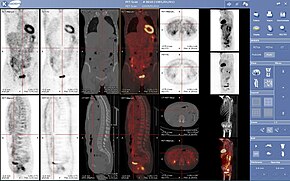This article needs additional citations for verification. (September 2014) |
| PET-CT | |
|---|---|
 A complete body PET / CT Fusion image | |
| OPS-301 code | 3-75 |
Positron emission tomography–computed tomography (better known as PET-CT or PET/CT) is a nuclear medicine technique which combines, in a single gantry, a positron emission tomography (PET) scanner and an x-ray computed tomography (CT) scanner, to acquire sequential images from both devices in the same session, which are combined into a single superposed (co-registered) image. Thus, functional imaging obtained by PET, which depicts the spatial distribution of metabolic or biochemical activity in the body can be more precisely aligned or correlated with anatomic imaging obtained by CT scanning. Two- and three-dimensional image reconstruction may be rendered as a function of a common software and control system.[1]
PET-CT has revolutionized medical diagnosis in many fields, by adding precision of anatomic localization to functional imaging, which was previously lacking from pure PET imaging. For example, many diagnostic imaging procedures in oncology, surgical planning, radiation therapy and cancer staging have been changing rapidly under the influence of PET-CT availability, and centers have been gradually abandoning conventional PET devices and substituting them by PET-CTs. Although the combined/hybrid device is considerably more expensive, it has the advantage of providing both functions as stand-alone examinations, being, in fact, two devices in one.
The only other obstacle to the wider use of PET-CT is the difficulty and cost of producing and transporting the radiopharmaceuticals used for PET imaging, which are usually extremely short-lived. For instance, the half-life of radioactive fluorine-18 (18F) used to trace glucose metabolism (using fluorodeoxyglucose, FDG) is only two hours. Its production requires a very expensive cyclotron as well as a production line for the radiopharmaceuticals. At least one PET-CT radiopharmaceutical is made on site from a generator: Ga-68 from a gallium-68 generator.
Benefits of PET-CT [2]
- By diagnosing with the help of a PET-CT, the advantages of the two individual methods are combined, and the result considerably exceeds images obtained by the two devices taken separately.
- The method allows identification of all cancerous formations in the body, regardless of their size or degree of development.
- The diagnosis time is short, the doctor can thus save precious time in the fight with the disease
- The substance used, although it is radioactive, presents a very low degree of risk, it is naturally eliminated by the body within a maximum of 24 hours after administration
PET-MRI, like PET-CT, combines modalities to produce co-registered images.
- ^ Shriwastav, Ravi; Gupta, Ravi Kant; Mittal, Ravi; Kumar, Rakesh; Poudel, Sagar; Yadav, Prakash Chand (2022-01-17). "Evaluation of Skeletal and Extra-Skeletal Tuberculosis by FDG-PET/CT with Clinical Correlation". doi:10.5281/zenodo.5866467.
{{cite journal}}: Cite journal requires|journal=(help) - ^ "PET CT Scan: Purpose, Procedure, Benefits".